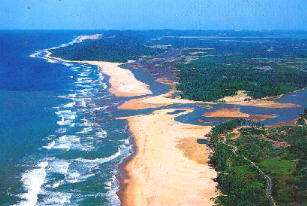Acoustic ecology
Acoustic ecology, sometimes called ecoacoustics or soundscape studies, is a discipline studying the relationship, mediated through sound, between human beings and their environment.[1] Acoustic ecology studies started in the late 1960s with R. Murray Schafer and his team at Simon Fraser University (Vancouver, British Columbia, Canada) as part of the World Soundscape Project. The original WSP team included Barry Truax and Hildegard Westerkamp, Bruce Davies and Peter Huse, among others. The first study produced by the WSP was titled The Vancouver Soundscape. The interest in this area grew enormously after this pioneer and innovative study and the area of acoustic ecology raised the interest of researchers and artists all over the world. In 1993, the members of the by now large and active international acoustic ecology community formed the World Forum of Acoustic Ecology.[2]
Every three years since the WFAE's founding at Banff, Canada in 1993, an international symposium has taken place. Stockholm, Amsterdam, Devon, Peterborough, and Melbourne followed. In November 2006, the WFAE meeting took place in Hirosaki, Japan.[3] Koli, Finland, was the meeting place of the latest WFAE world conference.
From its roots in the sonic sociology and radio art of Schafer and his colleagues, acoustic ecology has found expression in many different fields. While most have taken some inspiration from Schafer's writings, in recent years there have also been healthy divergences from the initial ideas. Among the expanded expressions of acoustic ecology are increasing attention to the sonic impacts of road and airport construction, widespread networks of "phonographers" exploring the world through sound,[4] the broadening of bioacoustics (the use of sound by animals) to consider the subjective and objective responses of animals to human noise, including increasing use of the idea of "acoustic ecology" in the literature, and a popular in the effects of human noise on animals, with ocean noise capturing the most attention. Acoustic ecology finds expression in many different fields, including niches as unique as historical soundscapes and psychosonography.[5][6]
List of compositional works
"Dominion" by Barry Truax
"Dominion" takes listeners on an acoustic journey across Canada. The work begins with the firing of the Noon Gun in St. John's harbour in Newfoundland and continues westward, recording sounds such as the Peace Tower bell in Ottawa and the O Canada Horn in Vancouver, along the way. A 12-piece orchestra, representing the 10 provinces and then two territories, carries listeners through the work, along with the whistle of a Canadian Pacific Railway train, representing the railroad that first connected Canada over a century ago.[7]
Acoustic Ecological Archeology
Marc E. Moglen (2007) recreated pre-historical Soundscapes (Acoustic Ecology) at University of California, Berkeley's Department of Anthropology, combining compositional techniques with site recordings for a non-diegetic piece in the virtual world of Second Life, on "Okapi Island". At the Center for New Media the acoustic ecological setting of the former jazz scene in Oakland, CA was developed for a virtual world setting.
"Soundmarks of Canada" by Peter Huse
"A composition recreating the acoustic profile of community sounds unique to Canadian locales, coast to coast". Source: Soundscapes of Canada.
See also
- Biophony
- Bernie Krause
- Lombard effect
- Marine mammals and sonar
- Fisheries acoustics
- Noise map
- Soundscape
References
- ↑ Wrightson, Kendall. "An Introduction to Acoustic Ecology" (PDF). WFAE. Archived from the original (PDF) on 15 April 2014. Retrieved 14 April 2014.
- ↑ "World Forum for Acoustic Ecology". Archived from the original on 11 December 2008. Retrieved 2008-12-17.
- ↑ "World Forum for Acoustic Ecology 2006, in Hirosaki, Aomori, Japan". November 2006. Archived from the original on 6 October 2008. Retrieved 2008-12-17.
- ↑ "phonography.org". Archived from the original on 20 December 2008. Retrieved 2008-12-17.
- ↑ Lee, John, David Hicks, Danah Henriksen, Punya Mishra, William Cain, Chris Fahnoe, Jon Good, Sarah Keenan, Rohit Mehta, Carmen Richardson, and Colin Terry. "Historical Soundscapes for Creative Synthesis." TechTrends 59, no. 5 (2015): 4-8. Retrieved 2016-08-23.
- ↑ Iosafat, Dani. "On Sonification of Place: Psychosonography and Urban Portrait" Organised Sound 14, no. 1 (2009): 47-55. Retrieved 2016-08-25.
- ↑ "Science of Sound", Canadian Geographic Online'
Bibliography
- Marcello Sorce Keller, “The Windmills of my Mind – Musings about Haydn, Kant, Sonic Ecology, and Hygiene”, in Gisa Jähnichen and Chinthaka Meddegoda (eds.), Music – Dance and Environment. Serdang: Universiti Putra Malaysia Press, 2013, 1–31.
External links
- Acoustic Ecology and the Soundscape Bibliography created by Maksymilian Kapelanski for Leonardo/ISAST
- Bazilchuk, Nancy. 2007. Choral Reefs: An inexpensive device monitors ocean health through sound. Conservation 8(1).
- "An Introduction to Acoustic Ecology" by Kendall Wrightson
- "Science of sound" Canadian Geographic
- Mailman, Joshua B. 2012. "Seven Metaphors for (Music) Listening: DRAMaTIC" in Journal of Sonic Studies v.2.


